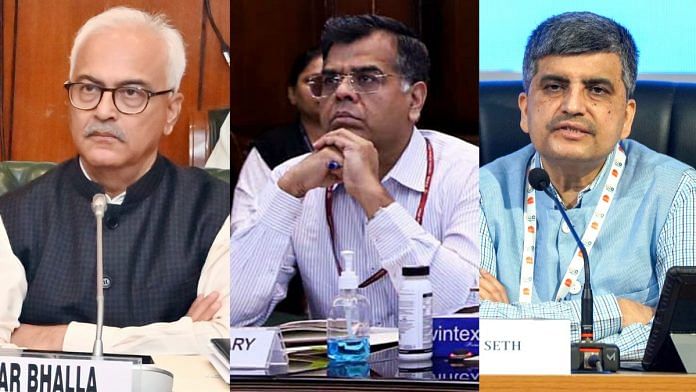New Delhi: When the Modi government had just come to power in 2014, the top bureaucracy had no semblance of certainty when it came to their tenures. Secretary-level officers were shunted from one ministry to another, often within months. Even secretaries in ministries with a fixed tenure of two years like defence, finance or home were frequently shifted out before the end of their tenures.
Ten years into the government, officers say the trend has completely reversed. Secretary-level officers have much longer tenures, with many serving in the same ministries for almost 3-4 years.
The example of Home Secretary Ajay Bhalla, who has been given four extensions, is obvious — he has been serving in the position since August 2019.
T.V. Somanathan, secretary in the finance ministry’s expenditure department, too has been serving in the position since December 2019. His colleague in the ministry’s Department of Investment and Public Asset Management (DIPAM), Tuhin Kanta Pandey, too was appointed as secretary of the department in October 2019.
While Bhalla, Somanathan and Pandey may be some of the longest serving secretaries in their respective departments in the present government, other officers too are getting to serve for much longer tenures than what was the average earlier.
Finance secretary Ajay Seth, and secretary in the ministry’s Department of Public Expenditure, Ali Raza Rizvi, for instance, have been serving in their respective positions since April 2021. Vivek Joshi, secretary in the financial services department, has been serving in the ministry since November 2022.
Apurva Chandra, who was appointed as health secretary in the government last month, previously served as Information and Broadcasting secretary for over two years from August 2021 to February 2022.
The secretaries in higher education, housing and urban affairs, and drinking water and sanitation, have all been serving in these positions since 2021.
The foreign and defence secretaries, Vinay Mohan Kwatra and Giridhar Aramane, who were appointed in these positions in May and November 2022, are yet to complete their tenures of two years, as the two ministries, along with finance, have a fixed tenure of two years.
“It is a very evident change in the governance style of this government…Officers are now spending more time in their ministries than ever before, bringing in a great deal of stability and continuity in governance,” said a secretary-level officer on condition of anonymity. “Even in UPA years, officers did not have such long tenures.”
“There is better coordination with states as well as between ministries as a result,” the officer said. “Earlier, if a state would ask for a sum for some project, by the time it would get approved, the secretary would change…Now, that does not happen. The whole idea of a ‘double engine sarkar’ also relies heavily on the stability and continuity within the bureaucracy.”
Also Read: Vacant posts, overburdened officials — why Haryana is asking Centre for more IAS officers
Officers with 18-36 months before superannuation prioritised
The change is not accidental. IAS officers being empanelled as secretaries increasingly have four-five years left before their superannuation. Twelve of the twenty officers empanelled as secretaries in February this year, for instance, have five years of service left.
“This is a huge change,” another officer serving in the government said. “Earlier, a lot of officers used to serve as secretaries for a few months almost for formality and prestige, as they could boast of retiring as secretary to government of India…Now, the government is only appointing those officers as secretaries who have at least 18-36 months left before superannuation.”
Sources in the government indicated that a major bureaucratic reshuffle will now happen after a new government comes to power, and several of the empanelled officers will then be appointed in different positions. “In the next government, the tenures of secretaries will become even longer,” the officer quoted above said.
In the first tenure of the Modi government, the problem of frequent transfer of officers, precluding them to oversee long-term projects, had become particularly grave. By 2018, the finance ministry had already had five secretaries, while the home ministry had had four secretaries, despite a fixed term of two years. The information and broadcasting ministry and the Department of Personnel and Training, on the other hand, each had five secretaries in four years.
Yet, the problem of frequent transfers has been one not restricted to any one government or even state, but one that afflicts the bureaucratic system as a whole. A paper published by the Carnegie Endowment International Peace in 2016, for instance, argued that the average tenure of an IAS officer in any given post was a mere 16 months despite the recommendations of several expert committees to have fixed tenures for officers for up to five years.
(Edited by Gitanjali Das)
Also Read: Why Bihar BJP is training guns on ally Nitish’s trusted man, controversial IAS officer KK Pathak



